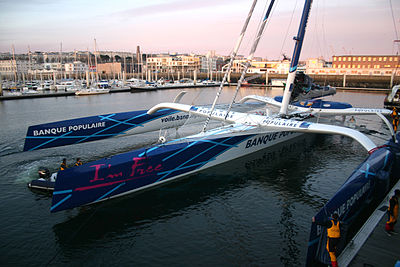
Search
Transatlantic sailing record

Since the five-week voyage of Christopher Columbus in 1492, crossing the Atlantic Ocean, quickly and safely, between Europe and the Americas has always been an important issue. Today, the route has become a classic one among skippers. The record is one of the most prestigious, next to the Jules Verne Trophy, for which it is often a good preparation.
This record can be achieved both ways: from west to east or from east to west. It can also be homologated single-handed or crewed, on monohulls or on multihulls. It is homologated, since 1972, by the WSSRC
From west to east
This route is the fastest, as it follows the prevailing westerlies. It is the one that meets the most interest among skippers. The crossing must be made from Ambrose Light of New York to an imaginary line linking Lizard Point, Cornwall to Ushant. The distance is around 2,880 nautical miles (5,330 km; 3,310 mi).
Crewed
Single-handed
From east to west
This crossing is made between Cadiz and San Salvador Island, for a distance of 3,884 nautical miles (7,193 km). It was also called Route of the discovery in honor of Christopher Columbus and his 1492 crossing.
Crewed
Bermuda to Plymouth
2,870 nautical miles
Dakar to Guadeloupe
2,551 nautical miles
Plymouth to Newport
2,800 nautical miles
Notes and references
See also
- Blue Riband
- Passage sailing record
- Single-Handed Trans-Atlantic Race
- Speed sailing record
- Transatlantic crossing
- World Sailing Speed Record Council
Text submitted to CC-BY-SA license. Source: Transatlantic sailing record by Wikipedia (Historical)
Owlapps.net - since 2012 - Les chouettes applications du hibou


